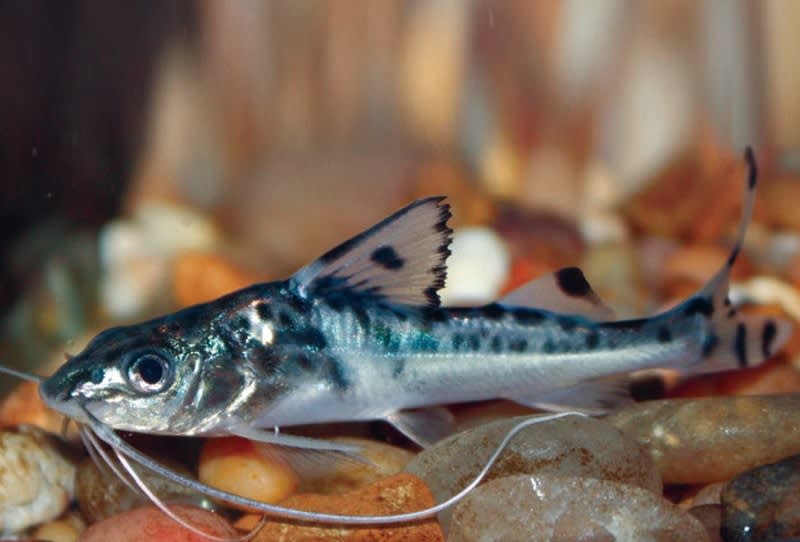How to Tell if My Catfish Is Pregnant
Catfish
includes catfish species
Catfish can be identified by their whisker-like barbels, which they use to locate food in dark waters. Catfish vary from small, peaceful species to larger, more predatory species. These scaleless bottom feeders eat a wide variety of foods, including algae, small fish, prepared foods and scavenged debris.

Catfish Facts
| Average Adult Size | 2-48 inches long, depending on species |
| Average Life Span | depends on species |
| Diet | omnivore |
| Minimum Aquarium Size | 10+ gallons, depending on species |
| Water Temperature: | 72-82°F |
Diet
A well-balanced Catfish diet consists of:
- Sinking pellets or flake foods.
- Brine shrimp, mysis shrimp and bloodworms (live or frozen).
- Preferences vary by species.
Feeding
Things to remember when feeding your Catfish:
- Will scavenge food but need to be specifically fed.
- Feed prepared foods according to the directions on the packaging.
- Thaw frozen food before feeding.
Housing
- Keep in an appropriate size aquarium; provide proper filtration to maintain health and provide plenty of space for swimming and hiding places.
- Stable water quality and parameters are critical to the health of aquatic life. If you are unsure of your water quality, Petco provides free water testing.
Characteristics
- Some Catfish prefer to live in schools but can be happy alone (such as corys).
- Most Catfish like to swim at the bottom of the aquarium and need plenty of hiding places.
- Will scavenge for food and eat almost anything.
- Many species have barbs for defense.
Habitat Maintenance
- Daily: check filter, water temperature and other equipment.
- Weekly: check water quality at least once a week.
- Monthly: change 10-25% of the total volume of water every 2-4 weeks, or as needed.
- Introduce new inhabitants to the aquarium gradually.
Compatibility
- Some can be kept with most community fish of similar size and temperament, including other catfish.
Health
Signs of a Healthy Fish
- Clear eyes
- Eats vigorously
- Swimming at the bottom or sides of the aquarium
Avoid overcrowded conditions; they are a major cause of stress and disease. Maintain good water quality with regular water changes and adequate filtration.
Red Flags
- loss of color or appetite
- spots or fungus on body or mouth
- cloudy eyes
- listlessness
- labored breathing
- erratic swimming
- weight loss
- bloating
Common Health Issues
| Health Issue | Symptoms or Causes | Suggested Action |
|---|---|---|
| Health Issue Fin rot | Symptoms or Causes Frayed or disintegrating fins; the base of the fins usually reddens. | Suggested Action Improve water quality; consult your aquatic veterinarian for treatment. |
| Health Issue Fungus | Symptoms or Causes White cottony growth and/or discoloration of the eyes. | Suggested Action Quarantine fish; use a commercial antifungal remedy as directed. |
| Health Issue Bacterial infections | Symptoms or Causes Cloudy eyes, open sores and/or reddening of the skin. | Suggested Action Improve water quality; use a commercial antibacterial remedy as directed. |
| Health IssueIch | Symptoms or Causes White spots appear on fins and body; fish rubs against hard objects or swims awkwardly. Rapid respirations. | Suggested Action Quarantine fish immediately; use a commercial ich remedy for at least two weeks. |
Sources
Ask a store partner about Petco's selection of books on catfish and the variety of private brand products available for the care and happiness of your new pet. All private brand products carry a 100% money-back guarantee.
Because all aquatic life are potential carriers of infectious diseases, such as Atypical Mycobacterium and Salmonella, always wash your hands before and after handling your aquatic life or habitat contents to help prevent the potential spread of disease.
Pregnant women, children under the age of 5, senior citizens and people with weakened immune systems should contact their physician before purchasing or caring for aquatic life and should consider not having aquatic life as a pet.
Go to cdc.gov/healthypets for more information about aquatic life and disease.
This care sheet can cover the needs of other species.
Note: The information on this Care Sheet is not a substitute for veterinary care. If you need additional information, please refer to the sources on the following page or contact your veterinarian as appropriate.
Developed with and approved by a qualified veterinarian.
Catfish
How to Tell if My Catfish Is Pregnant
Source: https://www.petco.com/content/petco/PetcoStore/en_US/pet-services/resource-center/caresheets/catfish.html
0 Response to "How to Tell if My Catfish Is Pregnant"
Post a Comment